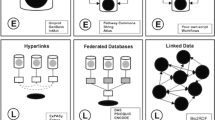Abstract
The term ‘biological resources’ is applied to the living biological material collected, held and catalogued in culture collections: bacterial and fungal cultures; animal, human and plant cells; viruses; and isolated genetic material. A wealth of information on these materials has been accumulated in culture collections, and most of this information is accessible. Digitalisation of data has reached a high level; however, information is still dispersed. Individual and coordinated approaches have been initiated to improve accessibility of biological resource centres, their holdings and related information through the Internet. These approaches cover subjects such as standardisation of data handling and data accessibility, and standardisation and quality control of laboratory procedures. This article reviews some of the most important initiatives implemented so far, as well as the most recent achievements. It also discusses the possible improvements that could be achieved by adopting new communication standards and technologies, such as web services, in view of a deeper and more fruitful integration of biological resources information in the bioinformatics network environment.





Similar content being viewed by others
References
United Nations Environment Programme (UNEP). An overview on genetic resources. Nairobi: UNEP, 1980. Report no.: 5
Iizuka H. Opening address. In: Iizuka H, Hasegawa T, editors-in-chief. Proceedings of the International Conference on Culture Collections; 1968 Oct 7–11; Tokyo. Baltimore (MD): University Park Press, 1970
Organisation for Economic Cooperation and Development (OECD). Workshop on Scientific and Technological Infrastructure (Support for Biological Resource Centres [BRCs]); 1999 Feb 17–18; Tokyo. Paris: OECD. OECD document no.: DST1/STP/8IO[99]
Organisation for Economic Cooperation and Development (OECD). Biological resource centres: underpinning the future of life sciences and biotechnology. Paris: OECD, 2001
Martin SM, Quadling C. World Directory of Culture Collections. In: Iizuka H, Hasegawa T, editors-in-chief. Proceedings of the International Conference on Culture Collections; 1968 Oct 7–11; Tokyo. Baltimore (MD): University Park Press, 1970: 133–7
Miyazaki S, Sugawara H. Networking of biological resource centers: WDCM experiences. Data Sci J 2002; 1(2): 229
Skerman VBD. World directory of collections of cultures of microorganisms. New York: John Wiley Sons Inc., 1972
Gams W, Hennebert GL, Stalpers J, et al. Structuring strain data for storage and retrieval of information on fungi and yeasts in MINE, the Microbial Information Network Europe. J Gen Microbiol 1988; 134: 1667–89
Aguilar A, editor. Report EN (1990) MINE, the Microbial Information Network Europe. Brussels: European Community, 1990 [Available from the Bap Programme Office, CEC, DG XII, 200 Rue de la Loi, B-1049 Brussels, Belgiu
Stalpers JA, Kracht M, Janssens D, et al. Structuring strain data for storage and retrieval of information on bacteria in MINE, the Microbial Information Network Europe. Syst Appl Microbiol 1990; 13: 92–103
Romano P, Iannotta B, Rondanina G, et al. The Interlab Project Network for Biomedical Research. Bioinformatics 1992; 1(3): 4–11
Romano P, Aresu O, Iannotta B, et al. Interlab Project Databases: an effort towards the needs of a wider body of unskilled users. Binary 1993; 5: 66–72
Organisation for Economic Cooperation and Development (OECD). Final report of the OECD Megascience Forum Working Group on Biological Informatics, January, 1999 [online]. Available from URL: http://www.oecd.org/dataoecd/24/32/2105199.pdf [Accessed 2005 Sep 30]
Edwards JL, Lane MA, Nielsen ES. Interoperability of biodiversity databases: biodiversity information on every desktop. Science 2000; 289(5488): 2312–4
Global Biodiversity Information Facility (GBIF). Memorandum of understanding for the Global Biodiversity Information Facility [online]. Available from URL: http://www.gbif.org/GBIF_org/GBIF_Documents/mou_html [Accessed 2005 Sep 30]
Etzold T, Argos P. Transforming a set of biological flat files libraries to a fast access network. Comput Appl Biosci 1993; 9: 59–64
Etzold T, Ulyanov A, Argos P. SRS: information retrieval system for molecular biology data banks. Methods Enzymol 1996; 266: 114–28
Zdobnov E, Lopez R, Apweiler R, et al. The EBI SRS server: new features. Bioinformatics 2002; 18(8): 1149–50
Zdobnov E, Lopez R, Apweiler R, et al. The EBI SRS server: recent developments. Bioinformatics 2002; 18(2): 368–73
Cabri. Guidelines for catalogue production [online]. Available from URL: http://www.cabri.org/guidelines/catalogue/CPcover.html [Accessed 2005 Sep 30]
Guerrini VH, Jackson D. Bioinformatics and extended markup language (XML). Online J Bioinformatics 2000; 1: 1–13
Achard F, Vaysseix G, Barillot E. XML, bioinformatics and data integration. Bioinformatics 2001; 17(2): 115–25
Romano P, editor. Proceedings of NETTAB 2001 Workshop on XML and CORBA: Towards a Bioinformatics Integrated Network Environment; 2001 May 17–18; Genoa, Italy. Genoa: Advanced Biotechnology Center (ABC), 2001 [Available from the corresponding author]
Spellman PT, Miller M, Stewart J, et al. Design and implementation of microarray gene expression markup language (MAGE-ML). Genome Biol 2002; 3(9): 1–9
Stein L. Creating a bioinformatics nation. Nature 2002; 417: 119–20
Jamison DC. Open bioinformatics. Bioinformatics 2003; 19(6): 679–80
Wilkinson MD, Links M. BioMOBY: an open-source biological web services proposal. Brief Bioinform 2002; 3(4): 331–41
Wang L, Riethoven JJM, Robinson AJ. XEMBL: distributing EMBL data in XML format. Bioinformatics 2002; 18(8): 1147–8
Acknowledgments
The authors wish to thank all researchers who contributed to the setting up of CABRI services and are now supporting the objectives of the EBRCN project. Many thanks go to Beatrice Dutertre (CERDIC, France) and Martine Vanhoucke (BCCM/LMBP, Belgium) who commented on the draft versions of this paper. And a very special thanks goes to Brendan Vaughan who implemented the very first version of the CABRI site and created the original versions of the Perl scripts.
EU funded project “Common Access to Biotechnological Resources and Information - CABRI”, 4th Framework Programme, Biotechnology, BI-O4-CT96-0231, 1996–1999. EU funded project “European Biological Resource Centers Network - EBRCN”, 5th Framework Programme, Area 14: Research Infrastructures, QLRI-CT-2000-00221 and QLRT-2001-02806, 2001–2004.
The authors have no conflicts of interest that are directly relevant to the content of this review.
Author information
Authors and Affiliations
Corresponding author
Rights and permissions
About this article
Cite this article
Romano, P., Kracht, M., Manniello, M.A. et al. The Role of Informatics in the Coordinated Management of Biological Resources Collections. Appl-Bioinformatics 4, 175–186 (2005). https://doi.org/10.2165/00822942-200594030-00002
Published:
Issue Date:
DOI: https://doi.org/10.2165/00822942-200594030-00002




